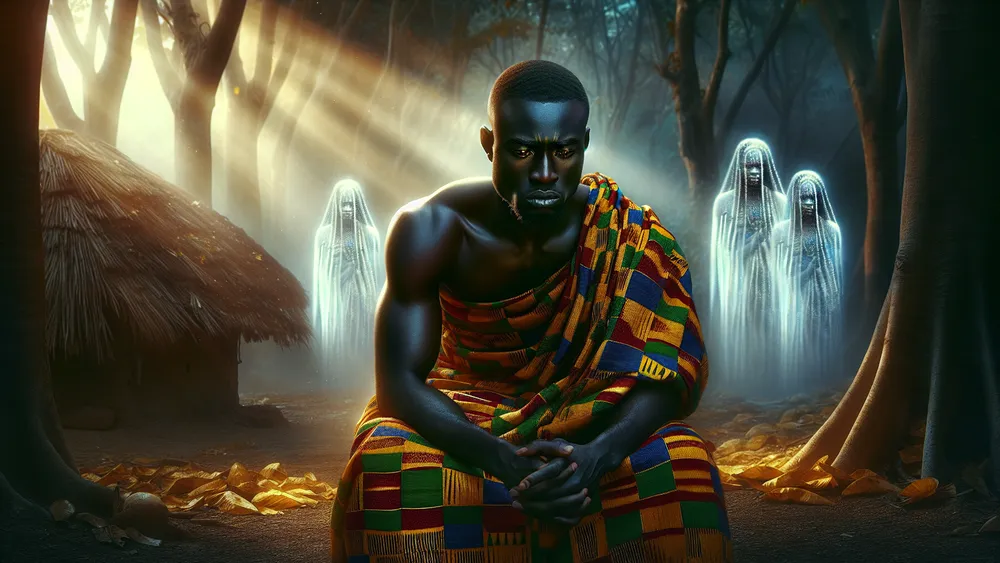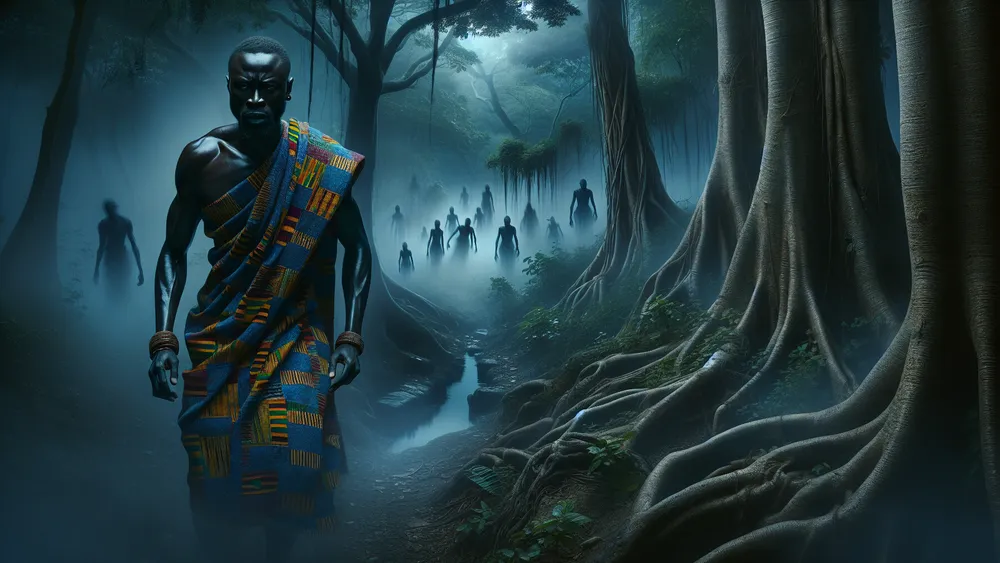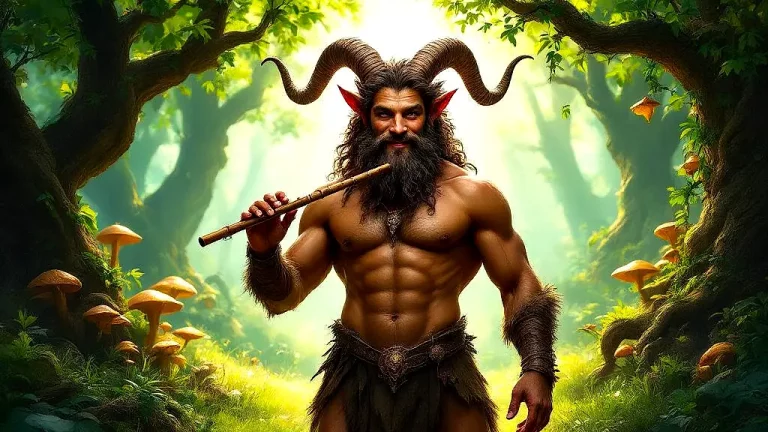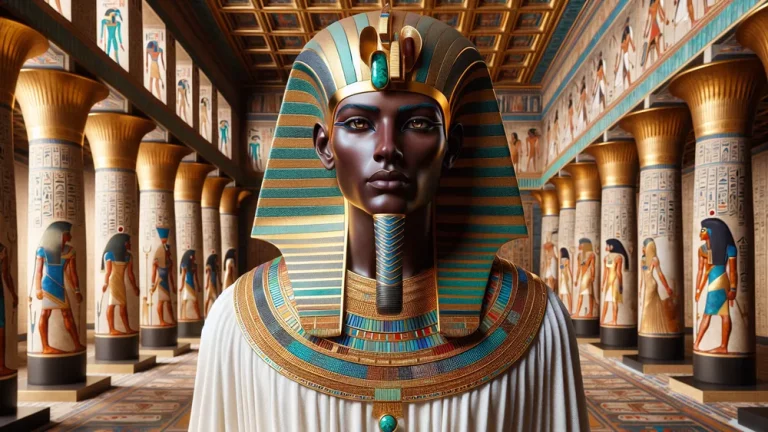Kwase Benefo: The Ashanti Hero Who Traveled To The Underworld
People everywhere, for a very long time, have told stories about heroes who travel to the world of the dead. These tales exist in different cultures, whether it’s the well-known Greek story of Orpheus or the much older Sumerian story about Inanna.
Key Points:
- Kwase Benefo, an Ashanti hero from Ghana, lost many wives and traveled to the land of the dead, trying to bring them back.
- The Ashanti believe that after death, people continue to exist as spirits who watch over or sometimes interfere with the living.
- His journey was dangerous, with barriers blocking him, spirits testing him, and rulers of the dead deciding his fate.
- In most versions of the story, the rulers refused his request because life and death must stay as they are, and the dead cannot return.
- His story is like myths from other places, such as Orpheus from Greek mythology, who also tried to bring back a lost loved one but failed.
- Many African traditions believe the dead still matter to the living, while other myths often focus on judgment or punishment after death.
- The Ashanti underworld differs from Greek, Norse, and Egyptian ideas because spirits do not vanish forever; they stay connected to their families.
The Ashanti people, who live in what is now Ghana, have a hero named Kwase Benefo, and his story is about love, loss, and the human wish to stop death from taking away the people we care about. His life is full of deep sadness – he loses more than one wife, so he decides he must go to where the dead are, taking risks to bring back the one he loves most.
The Ashanti see life after death in a way that is different from what is common in either Western or Eastern beliefs, and their idea of a spirit world is one where people who have died continue on in a certain way.
If you look at the journey Kwase Benefo takes, it becomes possible to understand how the Ashanti think about sadness, destiny, and the connection between those who are alive and those who are not. This blog will go into his story, what life after death means to the Ashanti, and how his travels compare with other famous stories about going to the world of the dead.
Kwase Benefo: Overview and Key Facts
| Key Aspect | Details |
|---|---|
| Cultural Origin | Among the Ashanti people in Ghana, there is a famous story about Kwase Benefo, whose tale is part of their long tradition of telling stories and myths. |
| Mythological Role | People see him as both a man who suffers a lot and someone deep in sorrow, because the loss of his wives forces him to look for answers beyond the world of the living. |
| Main Conflict | He has a hard time with marriage, and after losing more than one wife, he believes there is no other way but to enter the place of the dead to find some kind of answer. |
| Important Themes | The story is about love, losing people, the idea of destiny, life after death, and also how those still alive remain connected to those who have passed away. |
| Journey to the Dead | He takes a risk and enters the land where the dead exist, desperately trying to see his wives again and asking if he can bring them back to where the living are. |
| Meaning Behind His Story | His travels are about more than just his own pain – they reflect the human struggle with grief and the fact that people cannot fully control their destiny or stop death from happening. |
| Compared to Other Myths | He does something similar to Orpheus from stories in Greece, since he tries to bring back someone he cares about from the afterlife, but his journey is unique because it comes from Ashanti beliefs. |
| Connection to Religion and Spirituality | This story matches Ashanti traditions about the way death works, how people honor their ancestors, and the idea that spirits of those who died are still connected to the living. |
The Legend of Kwase Benefo
Kwase Benefo’s story is about suffering, strength to keep going, and trying to understand the world of spirits. It is strongly connected to the stories told by the Ashanti people, who have many myths about life, death, and what happens after someone has passed away.
Before looking at what he went through, it is important to think about who he really was, the terrible events that changed the way his life would go, and what Ashanti beliefs about life after death mean. If people want to really know what happened to him, they will first have to look at all of these things together.
Who Was Kwase Benefo?
Kwase Benefo is remembered as an important person in the stories of the Ashanti people, and the reason people still talk about him is because of both the bad experiences he had and his strong will to try to change what was supposed to happen.
Among the people of Ghana, the Ashanti are one of the largest ethnic groups, and their stories and beliefs continue because they tell them through speech, passing them down from one person to another. Kwase Benefo’s story has been told for a long time, partly as a warning but also because it is about things all people experience.
He was just a normal person. But then things changed – one terrible event after another. Each of his wives passed away one after the other, and he could not stop feeling sad. In Ashanti beliefs about ancestors and spirits, those who have died are still connected to the living, and when someone dies, it does not always mean everything is over forever.
Many people accept this idea, but Benefo could not. He wanted to see his wives again, which made him different from those around him. Because he could not accept what had happened and kept searching for answers, he became a part of the myths people tell.
His story can be compared to Orpheus from Greek myths, since both of them tried to go after the ones they lost in the world of the dead. But Benefo was not a warrior or a god. He was an ordinary man dealing with a terrible situation.
That is why his story is about sadness, the strength to keep going, and the strong wish that many people have to see those who have died again.

Kwase Benefo, an ordinary man from Ashanti stories, went through deep sadness after losing his wives one by one and, unlike others who accepted death, he searched desperately for a way to see them again, which is why people still talk about him today.
The Deaths That Shaped His Destiny
Kwase Benefo’s life was filled with terrible losses, and these events became the main reason why people tell his story. While the exact details change depending on who is telling it, many agree that he truly cared about his wives, but things did not go well for him. One by one, they passed away, which left him feeling a kind of never-ending sadness that others might have simply accepted.
Among the Ashanti people, getting married was not only about personal connections. It was something much bigger, something important for families, for the way people lived, and for how they connected to spirits and traditions. This meant that for him to have lost one wife after another was not just about personal pain – it had a wider meaning.
People did not only see what happened to him as bad luck. Some thought there was something bigger at work, maybe something supernatural or something related to spirits. Others might have believed he was being punished by higher powers or that his ancestors were not happy with him.
But he did not just accept that this was how things had to be, and because of this, he could not stay still. His sadness was too strong, and he believed there had to be an answer somewhere, something outside the world of people who were still alive.
That is why he made the choice to do something almost no one had ever tried before – to go to the place where dead people go. In the way Ashanti people understand the world, their beliefs help explain why Kwase Benefo did what he did. They do not see death as the complete end of existence.
Instead, when someone dies, they move into the world of spirits, and they can still have an effect on the ones they left behind. People believe that past family members can protect, help, or even interfere with the living. That is why there are traditions for honoring them, and people expect those who die to go to that new place without being disturbed.
But trying to bring back people who had died was different – it was something that could break how things were supposed to work. Because Kwase Benefo was not accepting that he would never see them again, what he did was not just about sadness. He was facing things people cannot see, pushing against the way people believed life and death were connected.
That is why people still tell his story.
What the Ashanti Believe About Life After Death
For the Ashanti people, death does not mean everything stops. Instead, they believe that when someone dies, they keep existing in a different way, and they do things that still matter to their families and those who are still alive.
This idea is very different from what the ancient Greeks believed, where most souls go to a dark place called Hades, where they do not really do much, or from the Egyptians’ belief in Duat, where a person’s heart is weighed to decide what happens to them forever.
In Ashanti beliefs, the dead move to Asamando, the place of the dead, where they join the spirits of their ancestors, and instead of simply staying there without doing anything, they still have a role. They watch over, protect, and sometimes warn their living relatives – this can happen through dreams, signs, or important rituals.
People believe that spirits do not just leave forever but stay connected to families, and this idea is part of why there is so much deep respect for past family members. Families must keep a good relationship with the ones who came before them, because their well-being depends on keeping that connection strong. Burial ceremonies are not only about sadness.
They are also about making sure the dead person gets to Asamando properly, where they will take the right place among the other spirits who came before them. In many Western ideas, life after death is seen as something far away or something with a clear ending. But in Ashanti beliefs, the idea that the dead are still part of life is important.
They never really leave completely, and they remain part of the world, even though living people cannot see them.
Kwase Benefo’s Path to the Afterlife
Kwase Benefo could not accept what had happened, and because of that sadness, he went on a journey most would never take. He did not believe things had to stay the way they were, and he refused to let go of what he had lost, which led him to something unusual – his travel beyond the land of the living.
Before knowing what happened, it’s important to see what stood in his way. Understanding how he reached the world of living people means looking at the difficulties he went through and the spirits that helped him or made things harder for him.
Stepping Into the World of the Dead
Kwase Benefo’s journey into the place where dead people go was something no normal person had done before. In the stories told by the Ashanti, Asamando is not a faraway place that no one can ever reach. It is a place that exists at the same time as the world of living people.
But going there was not as simple as just deciding to – there were barriers between the two sides, and no one could pass them easily. People tell stories that say Kwase Benefo went to a place believed to be a path between life and death. Some say it was a river. Others say it was a forest. Some even believe it was a mountain.
In different parts of Africa, certain places like these stand for the space between two kinds of existence. In other stories, such as the one about the Greek hero Orpheus, people have also tried to go to the place of the dead, but much like him, Kwase Benefo had to face unknown dangers and prepare himself in a special way before he could cross over.
This was not just a trip. It meant facing things people do not really understand. Going from the world of living people to the place where spirits exist was not just about moving – it had a much bigger meaning. In many African stories, people believe that water is an essential thing separating life from death.
Some say Kwase Benefo reached a river that could not be crossed unless someone helped him or unless he used special words or actions people use in ceremonies. Trees and forests also matter in Ashanti ways of thinking because they stand for the difference between what is visible and what is not.
Some say that Kwase Benefo had to go into a place in the forest where no one was allowed, moving through complete darkness until he came out on the other side, which meant he was leaving behind the things that kept him tied to life. Every part of the journey proved that crossing into the land of the dead was not something just anyone could do. It required change.
His travel into Asamando did not happen without obstacles. Spirits that helped or blocked his way were part of what made this journey difficult. Ashanti beliefs say that getting into the place of spirits is controlled by powerful beings who make sure only the ones who are meant to go there can enter.
Some think they were past family members, some think they were special messengers of the gods, and others say they were beings whose job was to make sure the worlds stayed apart. Some stories tell that Kwase Benefo was asked difficult questions or made to take part in specific ceremonies before he could move forward.

In other traditions around the world, like Egyptian and Norse stories, dead souls also have to prove they are ready before they can enter the afterlife. Kwase Benefo went through the same thing – he had to make it through these tests if he wanted to find the spirits of his wives. If he failed, he would stay lost, unable to leave that world again.
Meeting Spirits and the Rulers of the Afterlife
When Kwase Benefo stepped into Asamando, the first thing he saw was many different spirits, each with a purpose. They were not just standing there. They each had a role. Some were there to watch over the place and protect it, while others had to decide if he was allowed to go further.
The most important of them were the rulers of the underworld, those who controlled what happened to the souls in that place. The first spirits he met were the voices of the dead who stood in his way – the ancestral spirits, who were once living but had long since passed.
They had great importance, as they were the ones who kept the connection between the dead and the living. They asked him why he had entered their world when living people did not usually belong there. In Ashanti stories, ancestors do not completely leave. They still have power, sometimes giving advice through dreams.
But that was not the same as a living man walking into their land without permission. Then came the messengers of the underworld, whose job was to make sure only those who had the right to be there could go forward. Kwase Benefo was tested. They wanted to see if he truly meant to find his wives or if he was just another person who did not belong there.
Each challenge stood in his way. Without passing them, he could not keep going. The last and most powerful were those who ruled over the land of the dead, who were the ones that made all final decisions. Different names for them exist in the stories people tell, but the idea remains the same: even after people die, they are still part of a system with rules.
The dead do not simply wander without purpose – there are those in charge of them. These rulers had to decide if Kwase Benefo had any right to make requests in their world. In many other traditions, similar figures exist, such as Osiris in Egyptian beliefs or Minos in Greek stories. Like them, these rulers had to make sure everything stayed the way it was supposed to be.
For Kwase Benefo, these spirits mattered a lot in what happened next. Finding the spirits of his wives was not something he could do on his own. The rulers had to agree that his request was important enough. Otherwise, he too might have ended up staying in the land of the dead forever.
The Ferryman and the Journey of the Soul
In many African traditions, those who traveled between the two worlds helped guide the souls of the dead. People did not simply walk into the afterlife alone. In some stories, Kwase Benefo was not alone – there was a special being that helped him, often described as an ancestor or a powerful messenger. This figure had a critical job. It made sure he was doing what was right and prepared him for what was ahead.
This helper was similar to those in other traditions. The Greeks told of Charon, who was the boatman responsible for carrying souls across the River Styx. In Egyptian stories, the dead also needed a person to take them across water. But the Ashanti spirit worked differently.
Unlike Charon, who took people across only if they paid him, this guide did not simply take someone across – it made sure the person was ready first. Getting to that place was not just about moving past something – it also meant reaching a point where something about him had to change. He was not the same.
Many versions of the story say that before Kwase Benefo could move forward, he had to explain why he had come. He needed a reason. Stories from different places tell of heroes who had to prove themselves before entering a place where powerful beings lived. This idea means people believed that no person ever went through death alone. The spirits of those who passed before them made sure of that.
Even after dying, they were still connected to those who came after them.

In many African traditions, spirits or ancestors helped guide souls into the afterlife, making sure they were ready before moving forward, unlike in Greek and Egyptian stories where the dead simply needed to cross a river.
Asking the Underworld Rulers for His Wives’ Return
It was only after everything he had been through that Kwase Benefo stood in front of the rulers who decided the fate of the dead. He asked with great emotion for his wives to be returned to him, explaining that he did not want to live alone for the rest of his life.
But his request was one that went against the way things were meant to be. In Ashanti beliefs, the rulers of Asamando had a job – they were responsible for making sure the dead stayed where they were supposed to. The request he made was not normal. Death was a change that could not be undone, and the dead were not meant to return.
Some stories say the rulers did listen, and they understood, but in the end, they said no. The way the world was set up could not be changed just because of what one person wanted. But other stories say something different. They tell that Kwase Benefo was not refused immediately. Instead, he was given a choice. Maybe there was a test.
Maybe he had to do something difficult first. Other traditions tell of times when the dead could only come back under very specific conditions. His request had a meaning connected to bigger ideas. People from many places have told stories of those who tried to get back those who had passed. Some of them failed. In Greek stories, there was a man named Orpheus.
He tried to bring back his wife, Eurydice, but lost her because he made a mistake at the last moment. In Japan, there was Izanagi. He went looking for Izanami, who had already become part of the dead, but could not accept what she had become.
These myths and Kwase Benefo’s story all explain what people believed about life and death – the dead must stay where they are, and the living must keep going, even if they do not want to. Kwase Benefo’s journey had not just been about seeing his wives again. It was about something more. It proved that no matter what someone felt, the way life and death worked could not be changed.
Themes and Symbolism in Kwase Benefo’s Story
What he wanted was clear, but there was more to it. Going to the land of the dead was not only about finding his wives again. His journey was connected to a meaning that is bigger than just his own story, something found in Ashanti beliefs.
From what happened to him, people can understand something important about fate, the line that separates being alive from being dead, and the role of ancestors in what happens in people’s lives.
Love, Loss, and Fate in African Legends
The idea that love can be taken away is deeply part of Ashanti stories, where people’s emotions are connected to forces greater than them. Kwase Benefo felt deep sadness when he lost his wives, and many African myths tell of people who felt the same.
Stories from Ashanti tradition speak of lovers torn apart, and this happens for different reasons – something magical, something about rules, or something else entirely. Either way, they try to be together again, but this comes with a price. These myths explain that love, while strong, is easily broken by what fate decides and by how the world is meant to be.
Unlike other myths, Ashanti beliefs focus on something else about love and fate. In Greek stories, Orpheus wanted to bring Eurydice back, but that was taken from him because of something he could not control. Egyptian myths tell of Isis, who tried to change what was meant to happen so she could bring Osiris back. But in Ashanti stories, things work differently.
The spirits of the dead have power, and they are not supposed to return to the world of the living. The belief that the dead must stay where they belong is important, and these myths are stories that warn people about what happens when this is challenged.
Heroes Who Cross Between Life and Death
In many African stories, important people travel to the place where the dead are. They do this for different reasons – some look for wisdom, strength, or people they have lost. Because he lost his wives, Kwase Benefo went to Asamando. Others enter the world of spirits for different reasons. They do not always try to bring someone back.
There are a few well-known examples of this, such as:
- Sundiata Keita (Mali mythology) – He founded the Mali Empire. Some stories say that he spoke to spirits to learn things people needed to know.
- Nyikang (Shilluk mythology, South Sudan) – He was the first king of the Shilluk. Many believe that he moved between the world of the living and the world of the dead, and even after he died, he still had an effect on the people. This follows the belief that great leaders never really go away.
- Kintu (Baganda mythology, Uganda) – The first man in stories told by the Baganda people. Some say that he faced challenges in the spirit world, which helps people understand that staying strong and ancestors are important.
Each of these figures experiences the small separation between life and death in different ways, and some bring something back from it. Kwase Benefo wanted his wives to return, but that could not happen, proving how death cannot be avoided. But others come back with knowledge, strength, or power in the spirit world. This is not only found in African traditions.
In Greek stories, Orpheus tried to bring back Eurydice, but failed because of something he could not control. The Mesopotamian myth of Gilgamesh tells of a man who wanted to escape death forever, only to learn that people must accept that they do not live forever.
These repeated stories explain how many people want to change what death means, but different cultures decide how life and death work in their own way.
The Afterlife as a Place of Lessons and Consequences
In many African traditions, the afterlife is more than just a place where the dead go. It is a place where people may learn, think about what they have done, and experience the results of their actions. Ashanti beliefs say that how a person behaves while alive affects what happens after death, and that spirits pay attention to what a person does.
If a person was good, people remember them and give them respect in their family. But if they were selfish, dishonest, or caused problems, their spirit may struggle to find peace. Some traditions divide the afterlife into clear opposites. African traditions do something different. Instead of just rewards and punishments, spirits may help guide people even after they have died, and ancestors may still have an effect on the world of the living.
Because of this belief, death does not mean someone is completely gone. Instead, what a person leaves behind still matters in a spiritual way. Other traditions also connect the afterlife with judgment, but not always in the same way. In Ancient Egypt, the dead had their hearts weighed. If their heart was heavier than the Feather of Ma’at, they lost any chance to change things.
In Norse beliefs, people were judged differently depending on how they lived and how they died – some went to Valhalla, others to Helheim. Unlike Valhalla, Helheim was not a place of pain, but it did not include the great warriors. Greek stories describe a similar idea, with some souls going to Elysium while others are sent to Tartarus.
Yet something is different in beliefs like those of the Ashanti or Yoruba. The dead are not finished with the world. They may help or watch over their descendants, and in some cases, they try to correct mistakes they once made when alive. This helps explain that morality does not stop with death. It can still change what happens to people and their families later.
Unlike some traditions that focus on strict rewards or punishments, many African beliefs see the afterlife as a place where spirits continue to influence the world, guiding and affecting the lives of the living based on their past actions.
The Afterlife in Different Myths
While African traditions focus on morality, ancestors, and what happens in the spirit world because of what someone did, ideas about life after death are different in many places. All over the world, different people have come up with their own ideas about what happens once life ends. Looking at these traditions side by side helps people see what is the same and what is not.
Some ideas focus on judgment. Others focus on how past family members still matter. And some describe a world beyond death where spirits continue to exist in a new way. If we look at these traditions next to each other, we can see both what makes them alike and what makes them different in how they think about what happens after death.
How Does the African Underworld Stack Up Against Others?
The idea of the underworld is different in many ways across different cultures, and it helps explain what people think about death, right and wrong, and what happens after life ends. In African beliefs, including those from the Ashanti, Yoruba, and Bantu-speaking peoples, the underworld is not really a final stop, but more like a life that does not fully stop, where spirits still have a link to those who are alive.
Instead of keeping these worlds apart, many African beliefs suggest that spirits still affect the living, helping them or punishing them when they deserve it. In Greek stories, the afterlife is a place where souls are kept apart based on their type. Those who were good go to Elysium, regular people stay in the Asphodel Meadows, and those who were bad are sent to Tartarus.
Some Egyptian beliefs focus on who decides what happens after death, where hearts are weighed to see if someone can continue existing or if they are destroyed. Norse mythology does something different, since a person’s afterlife depends mostly on how they died. Warriors may reach Valhalla, but others end up in Helheim, which is not always a bad place, but it does keep them away from warriors.
The table below lists some of these differences to make them clearer:
| Feature | African Underworld (Ashanti, Yoruba) | Greek Underworld | Norse Afterlife | Egyptian Afterlife |
|---|---|---|---|---|
| Who Rules? | Spirits, ancestors, sometimes gods like Olorun or Nyame | Hades, Persephone | Hel (underworld goddess), Odin (Valhalla) | Osiris (judge of the dead) |
| How Are Souls Judged? | Based on moral living, with judgment from ancestors | Sorted into Elysium, Asphodel, or Tartarus by Minos, Rhadamanthus, and Aeacus | Warriors go to Valhalla; others go to Helheim | The Weighing of the Heart decides if a soul continues or is destroyed |
| Can the Dead Influence the Living? | Yes, ancestors guide, bless, or punish descendants | No, except through necromantic rituals | Rarely, though spirits may appear in dreams or signs | No, judgment is final |
| Is the Afterlife a Place of Reward or Punishment? | More of a continuation; spirits retain influence | Divided into reward (Elysium), neutral (Asphodel), and punishment (Tartarus) | Warriors are rewarded with Valhalla; others are separated in Helheim | Those who pass judgment live eternally in the Field of Reeds; others are annihilated |
This comparison explains that African traditions focus more on how ancestors stay involved with the living, while Greek and Egyptian beliefs are more about deciding if a person was good or bad, and Norse ideas depend mostly on whether someone died in battle.
The Great Rulers of the African Afterlife
Different spirits and gods are in charge of what happens to the dead. Some decide where souls go, while others judge people for their actions. In some beliefs, only one god controls what happens to the dead, but in many African traditions, things work differently. The way spirits are ranked is not always fixed, and several powerful beings might have control over different parts of the afterlife. Some of the most well-known ones include:
- Nyame (Ashanti, Ghana) – A powerful god of the sky. Nyame is important in both life and death, since he decides what happens to a person’s spirit because of their actions. Even though he does not only rule the afterlife, he still has authority over it.
- Olorun (Yoruban, Nigeria) – The highest god in Yoruba beliefs. He oversees the place where family members who died continue to exist. But unlike Hades in Greek stories or Osiris in Egyptian religion, he is mostly a distant figure rather than a god who directly judges souls.
- Moru (Dinka, South Sudan) – A powerful being who is connected to both justice and punishment. Moru decides whether a person deserves to be judged after death.
- Kibuka (Buganda, Uganda) – A spirit of war. He leads the souls of warriors who die in battle, which is similar to how Norse mythology says that fallen fighters go to Valhalla.
- Kalunga (Bantu, Central Africa) – A spirit that controls the line between life and death, making sure souls move to the right place after they die.
Because of these spirits, the living and dead are connected in the right way. They decide whether souls are at peace, continue to guide the living, or face judgment because of what they did in life.
Pantheon of African Mythology Gods
In African traditions, there are many gods, spirits, and ancestors that people believe in, and each one has an essential role in how people think about gods, the universe, and nature. In Greece or Norse mythology, gods are grouped together in one large system, but different places have different gods in Africa.
People in one region might follow gods that people elsewhere do not, though many ideas, like creation, destiny, and life after death, appear in different traditions. Among the many gods, some of the most famous ones are Nyame (Ashanti, Ghana), who is the most powerful sky god, Olorun (Yoruban, Nigeria), who is the main god in charge of the heavens, and Anansi, a god who is smart, plays tricks, and tells stories.
The link below has a much longer list of gods from different African traditions: full list with all African Gods
FAQs
1. Who was Kwase Benefo, and why is his story significant?
Who Kwase Benefo was ties directly to Ashanti mythology, as he was a tragic hero whose journey to the underworld symbolizes resilience, love, and the search for understanding in the face of immense personal loss.
2. What lessons does Kwase Benefo’s journey to the underworld teach?
The lessons Kwase Benefo’s journey to the underworld teaches revolve around the inevitability of fate, the limits of human desire, and the importance of accepting loss as a part of life.
3. How does the Ashanti view of the afterlife compare to other mythologies?
The Ashanti view of the afterlife differs from other mythologies in that it emphasizes a continued connection between the living and the dead, where ancestral spirits actively influence the mortal world rather than existing in a strictly separate or judgment-based afterlife.
4. Are there other African myths about heroes who visited the underworld?
Other African myths about heroes who visited the underworld include stories from different cultures, such as the Yoruba and Igbo, where individuals embark on perilous journeys to the realm of the dead to seek wisdom or retrieve lost loved ones.






